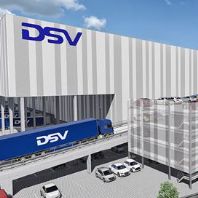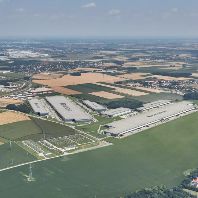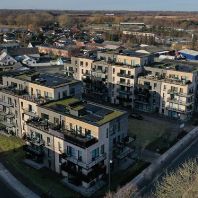Prime logistics rents in hub markets increased 2.8% y-o-y amid strong demand from supply chain users seeking modern distribution facilities to accommodate growing global trade and e-commerce activity, according to CBRE Group, Inc.’s inaugural Global Prime Logistics Rents report.
“Global consumer demand is strong, and an ever-increasing share of retail sales are taking place online, which is prompting traditional retailers, e-commerce companies and third-party logistics firms to seek out advanced ‘prime’ logistics warehouses to modernise their supply chains to facilitate the rapid delivery of goods,” said Richard Barkham, CBRE’s global chief economist.
Hong Kong topped the list of “most expensive” markets worldwide, with prime logistics rents of $28.94ft²/year (€279.7/m²), followed by Tokyo ($16.74/ft² or €161.79/m²) and London ($16.36/ft² or €158.12/m²). The top market in the Americas was Los Angeles-Orange County, ranked 12th globally at $8.04/ft² (€77.7/m²).
“Land-constrained markets command a significant rent premium,” noted David Egan, head of industrial and logistics research in the Americas for CBRE. “Markets where land is more plentiful, most notably major U.S. hubs like Chicago, Dallas-Fort Worth and Atlanta, are more affordable.”
Regionally, prime logistics rents were up 5.6% y-o-y in the Americas, 2.5% in Asia Pacific and 0.8% in EMEA. Eight of the 10 fastest-growing markets were in the Americas, led by Oakland (up 29.8% y-o-y), New Jersey (up 15.0% y-o-y), and the Inland Empire (up 13.5% y-o-y).
CBRE tracks prime rents—the highest achievable rents for the logistics facility of the highest quality and specification—in 68 logistics hubs around the world. Fifty-nine percent (40 markets) of tracked markets saw y-o-y increases in rents, 25% (17 markets) saw no change and only 16% (11 markets) saw decreases.
Americas
The sharp rise in prime rents in the Americas was largely due to massive growth in U.S. coastal markets, where relentless occupier demand drove up pricing. In Oakland, desire for quality premises is the dominant factor for inner-bay logistics users despite the high cost. New development in some markets, such as the Inland Empire, is commanding premium rates. In Latin America, Santiago and Ciudad Juarez notched increases in prime rent of 10.9% and 10.2%, respectively. In São Paulo, prime rents were down 10.5% y-o-y.
Asia Pacific
Despite the slowdown in China’s economy, 15 out of the 27 markets tracked in Asia Pacific experienced rent growth. Third-party logistics firms and retailers are taking a longer-term view and continue to upgrade their distribution networks. Seoul recorded 6.5% annual growth in prime rents as supportive government policies, rapid e-commerce growth and the modernisation of the logistics industry continues in South Korea. The small, open economies of Hong Kong and Singapore showed some weakness in rents as regional trade slowed, though they remain among the most expensive industrial markets worldwide.
EMEA
European markets saw more marginal gains overall, with several hubs experiencing no growth at all. The U.K. Midlands, London and Berlin saw the strongest growth, with an average of 7.9% y-o-y growth in prime industrial rents. These areas are seeing increased demand from e-commerce-related users as more Europeans shop online. On the other end of the spectrum, Moscow had the deepest decline, showing a 45.8% drop in prime industrial rents (measured in US dollars) due to declining oil prices that have led to recessionary conditions.
Olesya Dzuba, director, strategic analysis and planning department CBRE in Russia, said: “Prime logistics rents in Moscow Region declined two times in USD terms on the back of ruble devaluation. After the correction the market now offers attractive price levels for buying logistics, both to investors and end-users. It is now more efficient to purchase existing facility, or built-to-suit in the existing logistic parks, rather than constructing by themselves. Current pricing attracted new buyers on the market, both investors (Mubadala bought two large warehouse complex of about 200,000m²) and end-users, mostly large retailers. Sale price has approached the cost of construction, and the abilities for cost optimisation are almost over even for systemic developers. Inflation and imported construction materials will stimulate the growth of construction costs. In its turn it will result in increase of sale prices, thus closing the current window of opportunities.”
|
Global Prime Logistics Rents |
|||||||
|
Rank |
Market |
Rent (USD/ft²/year) |
Country |
Region |
|||
|
1 |
Hong Kong |
$28.94 |
Hong Kong |
Asia Pacific |
|||
|
2 |
Tokyo |
$16.74 |
Japan |
Asia Pacific |
|||
|
3 |
London |
$16.36 |
United Kingdom |
EMEA |
|||
|
4 |
Singapore |
$10.91 |
Singapore |
Asia Pacific |
|||
|
5 |
Stockholm |
$9.90 |
Sweden |
EMEA |
|||
|
6 |
Shanghai |
$9.44 |
China |
Asia Pacific |
|||
|
7 |
Manchester-Liverpool |
$8.75 |
United Kingdom |
EMEA |
|||
|
8 |
Leeds-Sheffield |
$8.45 |
United Kingdom |
EMEA |
|||
|
9 |
Sydney |
$8.34 |
Australia |
Asia Pacific |
|||
|
10 |
Shenzhen |
$8.27 |
China |
Asia Pacific |
|||
|
Top 10 Global Logistics Hubs by Prime Rent Growth |
||||||
|
Rank |
Market |
Annual % Change (in Local Currency) |
Country |
Region |
||
|
1 |
Oakland |
29.8% |
United States |
Americas |
||
|
2 |
New Jersey |
15% |
United States |
Americas |
||
|
3 |
Inland Empire |
13.5% |
United States |
Americas |
||
|
4 |
Midlands |
13% |
United Kingdom |
EMEA |
||
|
5 |
Santiago |
10.9% |
Chile |
Americas |
||
|
6 |
Ciudad Juarez |
10.2% |
Mexico |
Americas |
||
|
7 |
Los Angeles-Orange County |
9.8% |
United States |
Americas |
||
|
8 |
Dallas-Fort Worth |
8% |
United States |
Americas |
||
|
9 |
Atlanta |
6.8% |
United States |
Americas |
||
|
10 |
Seoul |
6.5% |
South Korea |
Asia Pacific |
||
|
Source: CBRE Research, Q4 2015. |
||||||
Note: All data is as of Q4 2015.















